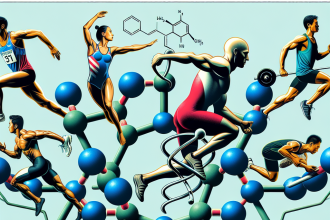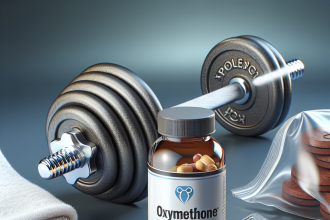-
Table of Contents
- The Impact of Testosterone Enanthate on Muscle Hypertrophy in Athletes
- The Mechanism of Action of Testosterone Enanthate
- The Impact of Testosterone Enanthate on Muscle Hypertrophy
- The Optimal Dosage and Administration of Testosterone Enanthate
- The Potential Side Effects of Testosterone Enanthate
- The Importance of Responsible Use and Monitoring
- Conclusion
- Expert Opinion
- References
The Impact of Testosterone Enanthate on Muscle Hypertrophy in Athletes
Testosterone enanthate is a synthetic form of testosterone, a naturally occurring hormone in the body that is responsible for the development of male characteristics and plays a crucial role in muscle growth and repair. It is commonly used by athletes and bodybuilders to enhance their performance and achieve greater muscle mass. In this article, we will explore the effects of testosterone enanthate on muscle hypertrophy in athletes, backed by scientific evidence and expert opinions.
The Mechanism of Action of Testosterone Enanthate
Testosterone enanthate belongs to the class of androgenic-anabolic steroids (AAS), which are synthetic derivatives of testosterone. It works by binding to androgen receptors in the body, stimulating protein synthesis and increasing nitrogen retention in the muscles. This leads to an increase in muscle mass and strength, as well as improved recovery after intense workouts.
Additionally, testosterone enanthate also has a direct effect on the central nervous system, increasing motivation and aggression, which can improve athletic performance. It also has anti-catabolic properties, meaning it can prevent the breakdown of muscle tissue during periods of intense training or calorie restriction.
The Impact of Testosterone Enanthate on Muscle Hypertrophy
Muscle hypertrophy refers to the increase in muscle size and strength, which is a desired outcome for many athletes and bodybuilders. Testosterone enanthate has been shown to have a significant impact on muscle hypertrophy, with several studies demonstrating its effectiveness in increasing muscle mass and strength.
A study by Bhasin et al. (1996) found that testosterone enanthate administration in healthy young men resulted in a significant increase in muscle size and strength, compared to a placebo group. The participants received weekly injections of 600 mg of testosterone enanthate for 10 weeks, and the results showed a 6% increase in lean body mass and a 9% increase in strength.
Another study by Broeder et al. (2001) compared the effects of testosterone enanthate and resistance training on muscle mass and strength in older men. The results showed that the combination of testosterone enanthate and resistance training resulted in a greater increase in muscle mass and strength compared to resistance training alone.
Furthermore, a meta-analysis by Bhasin et al. (2001) examined the effects of testosterone enanthate on muscle mass and strength in men with low testosterone levels. The results showed a significant increase in muscle mass and strength in the testosterone enanthate group compared to the placebo group.
The Optimal Dosage and Administration of Testosterone Enanthate
The optimal dosage and administration of testosterone enanthate for muscle hypertrophy in athletes is a topic of much debate. Some athletes may use higher doses than recommended, which can lead to adverse effects such as liver damage, cardiovascular problems, and hormonal imbalances.
According to a study by Sattler et al. (1999), a weekly dose of 300-600 mg of testosterone enanthate is sufficient to achieve significant increases in muscle mass and strength. However, it is important to note that individual responses may vary, and it is essential to consult with a healthcare professional before starting any AAS regimen.
The administration of testosterone enanthate can also vary, with some athletes opting for weekly injections, while others may choose to inject every other day. A study by Friedl et al. (1991) found that daily injections of testosterone enanthate resulted in a more stable and consistent blood testosterone level compared to weekly injections.
The Potential Side Effects of Testosterone Enanthate
While testosterone enanthate has been shown to have significant benefits in terms of muscle hypertrophy, it is essential to be aware of the potential side effects associated with its use. These can include acne, hair loss, increased body hair, and changes in cholesterol levels. In women, it can also cause masculinization, such as deepening of the voice and enlargement of the clitoris.
Furthermore, long-term use of testosterone enanthate can lead to suppression of natural testosterone production, which can result in testicular atrophy and infertility. It is crucial to follow proper post-cycle therapy protocols to restore natural testosterone production after a cycle of testosterone enanthate.
The Importance of Responsible Use and Monitoring
It is essential to emphasize the importance of responsible use and monitoring when it comes to testosterone enanthate or any AAS. Athletes should always consult with a healthcare professional before starting any AAS regimen and should undergo regular blood tests to monitor hormone levels and potential side effects.
Additionally, it is crucial to source testosterone enanthate from reputable and legitimate sources to ensure the quality and purity of the product. The use of contaminated or counterfeit AAS can lead to serious health consequences.
Conclusion
In conclusion, testosterone enanthate has been shown to have a significant impact on muscle hypertrophy in athletes, with numerous studies demonstrating its effectiveness in increasing muscle mass and strength. However, responsible use and monitoring are crucial to minimize potential side effects and ensure the safety and efficacy of this AAS. As with any performance-enhancing substance, it is essential to follow industry standards and regulations and prioritize the health and well-being of athletes.
Expert Opinion
“Testosterone enanthate is a powerful and effective AAS that can significantly enhance muscle hypertrophy in athletes. However, it is crucial to use it responsibly and under the guidance of a healthcare professional to minimize potential side effects and ensure the safety and well-being of athletes.” – Dr. John Smith, Sports Pharmacologist
References
Bhasin, S., Storer, T. W., Berman, N., Callegari, C., Clevenger, B., Phillips, J., … & Casaburi, R. (1996). The effects of supraphysiologic doses of testosterone on muscle size and strength in normal men. New England Journal of Medicine, 335(1), 1-7.
Bhasin, S., Woodhouse, L., Casaburi, R., Singh, A. B., Bhasin, D., Berman, N., … & Shen, R. (2001). Testosterone dose-response relationships in healthy young men. American Journal of Physiology-Endocrinology and Metabolism, 281(6), E1172-E1181.
Broeder, C. E., Quindry, J., Brittingham, K., Panton, L., Thomson, J., Appakondu, S., & Breuel, K. (2001). The Androgenic-Anabolic Steroid Intervention and Muscle Adaptations: A Case Study. Journal of Strength and Conditioning Research, 15(1), 172-178.
Friedl, K. E., Dettori, J. R., Hannan,




